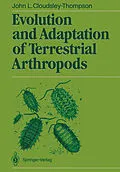1 Palaeontology and Phytogeny.- 1.1 The Earliest Arthropodan Fossils.- 1.2 The First Terrestrial Arthropods.- 1.3 Evolution in the Arthropods.- 1.3.1 Embryological Considerations.- 1.3.2 Comparative Morphology.- 1.3.3 Monophyletic or Polyphyletic Origins.- Further Reading.- 2 Implications of Live on Land.- 2.1 The Significance of Size.- 2.1.1 Size, Skeletons and Allometry.- 2.1.2 Allometric Growth.- 2.2 Water Relations.- 2.3 The Conquest of the Land.- 2.4 The Integument.- 2.4.1 The Endocuticle.- 2.4.2 The Exocuticle.- 2.4.3 The Epicuticle.- 2.5 Growth and Ecdysis.- 2.6 Respiration: Lung-Books and Tracheae.- 2.7 Nutrition and Excretion.- 2.7.1 Nutrition.- 2.7.2 Excretion.- 2.8 Ecological Considerations of Size.- Further Reading.- 3 The Conquest of the Land by Crustacea.- 3.1 Types of Adaptation.- 3.2 Transition from Water to Land in Amphipoda.- 3.3 Transition from Water to Land in Decapoda.- 3.4 Transition from Water to Land in Isopoda.- 3.4.1 Morphology.- 3.4.2 Physiology.- 3.4.3 Behaviour.- 3.5 Conclusion.- Further Reading.- 4 Insect Phytogeny and the Origin of Flight.- 4.1 Ancestry of Insects.- 4.2 The Origin of Wings.- 4.2.1 Aptelota and the Ancestry of Spiders.- 4.3 Paranoial Theory.- 4.4 Tracheal Gill Theory.- 4.5 Selection for Flight.- 4.6 Phytogeny of the Lower Insect Orders.- 4.6.1 Fossil Evidence.- 4.6.2 Palaeoptera and Neoptera.- 4.7 Wing Venation.- 4.8 The 'Panorpoid Complex'.- 4.9 Insect Flight.- Further Reading.- 5 Evolutionary Trends in Reproduction.- 5.1 Spermatophores and Their Phylogenetic Significance.- 5.2 Functions of Aggregation and Courtship.- 5.2.1 Aggregation and Swarming in Insects.- 5.2.2 Courtship.- 5.3 Indirect Spermatophore Transfer via the Substrate.- 5.3.1 Arachnida.- 5.3.2 Uniramia.- 5.4 Indirect Sperm Transfer.- 5.4.1 Arachnida.- 5.4.2 Insecta.- 5.5 Direct Copulation with Free Sperm.- 5.6 Haemocoelic Insemination.- 5.7 Conclusion.- Further Reading.- 6 Adaptations to Extreme Environments.- 6.1 Desert Adaptations.- 6.1.1 Morphological Adaptations.- 6.1.2 Physiological Adaptations.- 6.1.3 Behaviour and Rhythmic Activity.- 6.2 Forest Adaptations.- 6.2.1 Cryptozoa.- 6.2.2 Flying Insects.- 6.3 Arctic and Alpine Adaptations.- 6.4 Littoral and Aquatic Adaptations.- 6.4.1 Respiratory Adaptations.- 6.4.2 Plastron Respiration.- 6.5 Cavernicolous Adaptations.- 6.6 Suspended Animation.- 6.6.1 Diapause.- 6.6.2 Cryptobiosis.- Further Reading.- 7 Dispersal and Migration.- 7.1 Migration in Relation to Habitat.- 7.1.1 The Evolution of Arthropod Migration.- 7.1.2 Types of Migratory Movement.- 7.2 Migration in Relation to Population Dynamics.- 7.3 Migration Without Flight.- 7.3.1 Mass Migration on the Ground.- 7.3.2 Ballooning.- 7.3.3 Phoresy.- 7.4 Meteorological Aspects of Air-Born Insect Migration.- 7.4.1 Locusts.- 7.5 Orientation During Migration.- 7.5.1 Butterflies.- 7.5.2 Night-Flying Moths.- 7.5.3 Time-Compensated Celestial Navigation.- 7.6 Migration and Diapause.- 7.6.1 Physiology.- Further Reading.- 8 Defensive Mechanisms.- 8.1 Concealment from Vertebrate Predators.- 8.1.1 Cryptic Coloration.- 8.1.2 Protective Resemblance.- 8.1.3 Disguise with the Aid of Adventitious Materials.- 8.2 Advertisement with Respect to Vertebrate Predators.- 8.2.1 Aposematic Coloration.- 8.2.2 Mimicry.- 8.2.3 Thanatosis and Deflection of Attack.- 8.2.4 Deimatic Behaviour.- 8.3 Chemical Defences.- 8.3.1 Venoms.- 8.3.2 Repugnatorial Fluids.- 8.3.3 Urticating Hairs.- 8.4 Defences Against Small Invertebrate Enemies.- 8.5 Avoidance of Parasites.- Further Reading.- 9 The Success of Terrestrial Arthropods.- 9.1 Criteria of Success.- 9.2 Reasons for Success.- 9.3 Adaptability.- 9.3.1 Evolution of Sucking Mouthparts.- 9.3.2 Ectoparasitic Adaptations.- 9.4 Conclusion.- Further Reading.
